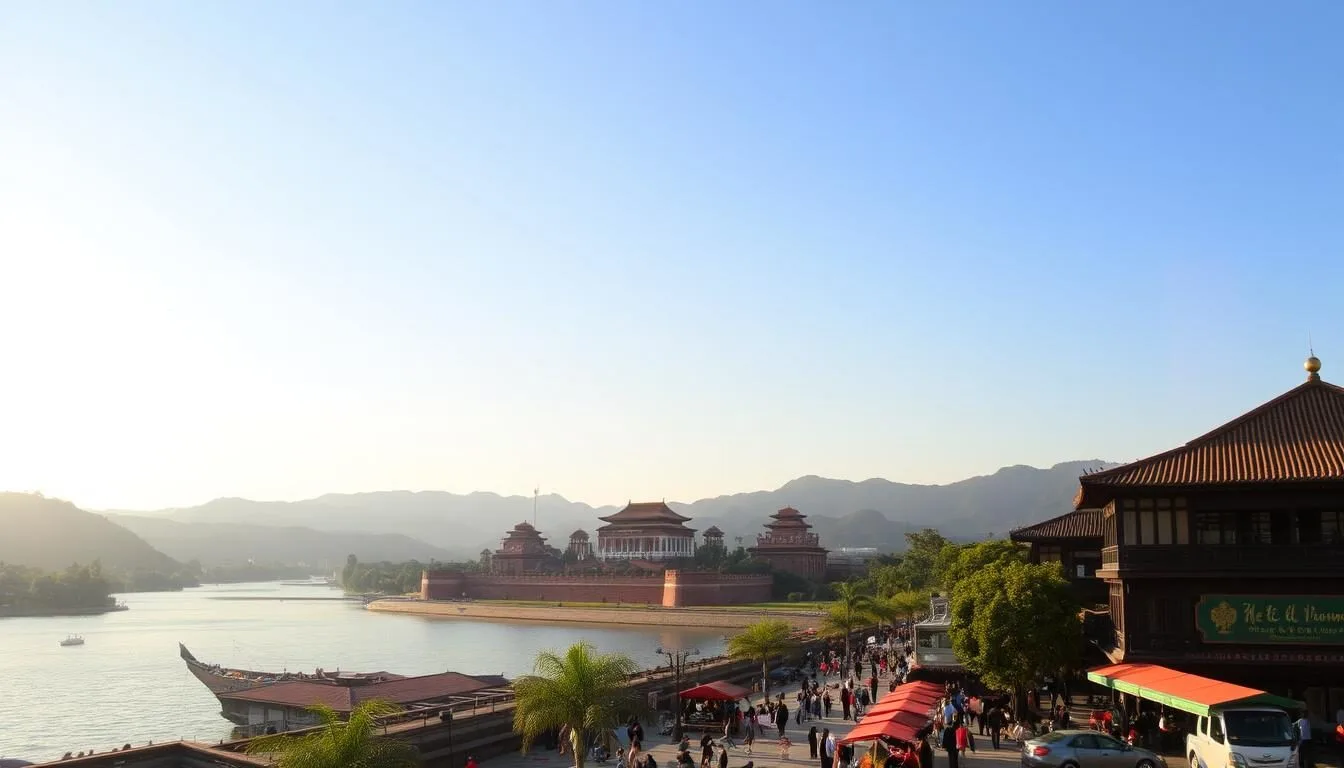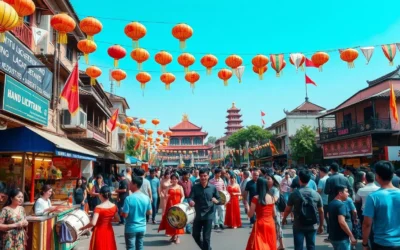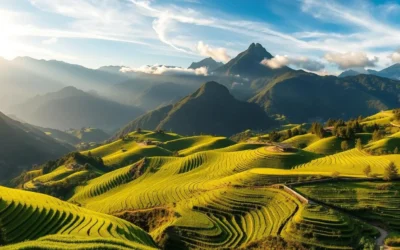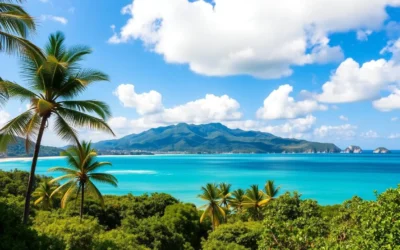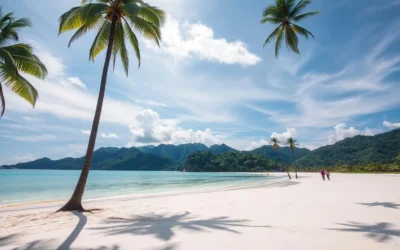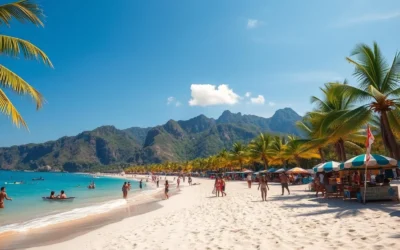✓ Accommodations✓ Flights✓ Rental Cars
Did you know that Hue, a city steeped in history along the Perfume River, experiences a climate that significantly impacts travel plans? With its weather patterns playing a crucial role in determining the quality of your trip, understanding the seasonal variations is key to a memorable visit.
Hue’s climate, influenced by the South China Sea, is characterized by two distinct seasons: the monsoon and the dry season. To make the most of your trip, it’s essential to choose the right time to visit, avoiding the periods of heavy rainfall and extreme heat.
As you plan your journey, you’ll want to align your travel interests with the most favorable weather conditions, ensuring a comfortable and enjoyable experience in this UNESCO World Heritage site. Let’s explore the optimal season for visiting Hue, helping you navigate the city’s unique climate patterns.
Discovering Hue: Vietnam’s Imperial Treasure
As you step into Hue, Vietnam, you’re immediately enveloped in a rich tapestry of history and culture. This city, once the imperial capital of Vietnam, is a treasure trove of cultural and historical experiences.
Hue’s Cultural and Historical Significance
Hue’s significance extends beyond its historical landmarks; it’s a city where tradition and heritage are palpable in every aspect of daily life. The city’s imperial citadel, a UNESCO World Heritage Site, stands as a testament to its glorious past, while the Perfume River adds a serene beauty to the landscape. As you explore Hue, you’ll discover a city that is deeply rooted in its history, yet vibrantly alive with cultural practices that have been preserved over centuries.
Geographical Location and Climate Influences
Located in central Vietnam, Hue’s climate is significantly influenced by its proximity to the South China Sea, just 12km to the east. This geographical positioning results in a weather pattern that is characterized by high humidity and variability. The Truong Son mountain range to the west creates a rain shadow effect, contributing to Hue’s distinct microclimate. Understanding these geographical influences is crucial for travelers planning their visit, as they directly impact the time of year you choose to visit.
The city’s unique geography, with the Perfume River running through it, not only adds to its scenic beauty but also plays a crucial role in shaping its climate. As you plan your trip to Hue, considering the weather and climate will ensure that you make the most of your visit.
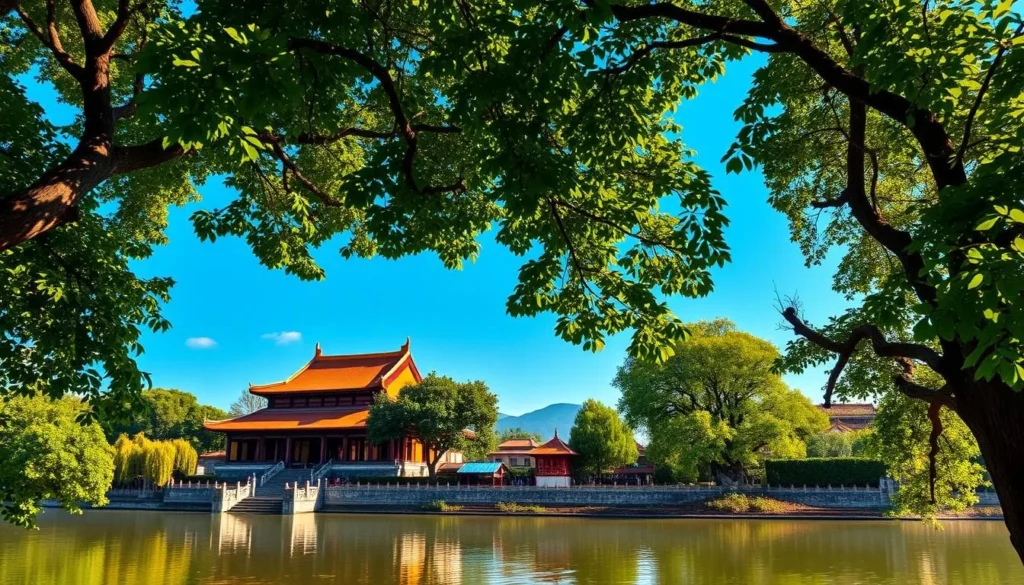
Understanding Hue’s Unique Climate Patterns
The city’s unique climate is shaped by its proximity to the South China Sea. Sitting on the banks of the Perfume River along the eastern coast of central Vietnam, Hue’s climate is influenced by the nearby sea, which brings humidity and causes variability in the climate.
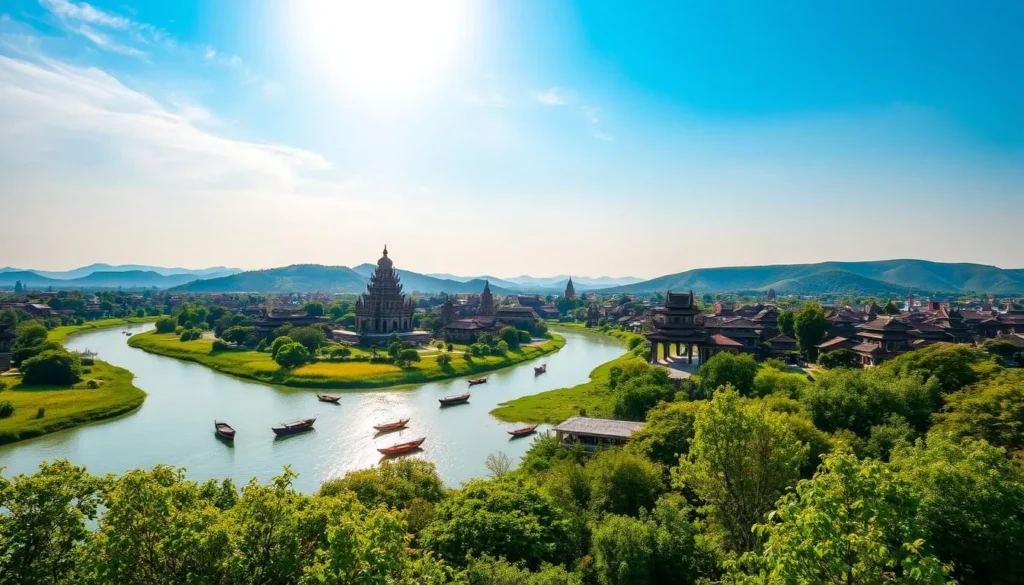
The Two-Season Climate System
Hue experiences a distinct two-season climate system, which is a crucial factor to consider when planning your travel or journey to this city. The two main seasons are characterized by significant differences in weather patterns.
- The dry season typically brings clear skies and pleasant temperatures.
- The wet season is marked by heavy rainfall and increased humidity.
Understanding these seasons is vital to making the most of your time in Hue.
How the South China Sea Affects Hue’s Weather
The South China Sea plays a pivotal role in shaping Hue’s climate. The sea’s influence moderates temperatures while introducing high humidity levels throughout the year. Some key effects include:
- Maritime air masses bringing moisture that contributes to significant rainfall, particularly during the monsoon season.
- The sea’s thermal inertia creating a lag effect in seasonal temperature changes, making transitions between seasons more gradual.
- Sea breezes providing relief from the heat during summer months, especially in coastal areas.
Recognizing the impact of the South China Sea on Hue’s weather helps explain why the city experiences sudden changes and why coastal excursions can offer climate relief during certain seasons.
Hue, Vietnam: Best Months for a Weather-Savvy Trip
For travelers to Hue, Vietnam, understanding the local climate is key to unlocking an unforgettable journey. The city’s rich cultural heritage and stunning landscapes are best appreciated when the weather conditions are favorable.
January to April: The Golden Period
The period from January to April is considered the golden time to visit Hue. This season comes at the end of the monsoon period, bringing clear skies and warmer weather. The landscape, lush and green after the monsoon rains, is further enhanced by the spring blossoms. Occasional showers during this time keep Hue’s charming parks and gardens picturesque.
- The peak tourist season in Hue coincides with its most favorable weather, typically running from February through April when conditions are consistently pleasant.
- Morning temperatures during this period usually start around 18-20°C (64-68°F) and rise to comfortable afternoon highs of 24-28°C (75-82°F).
- Rainfall is minimal during these months, with occasional brief showers that quickly give way to sunshine, rarely disrupting travel plans.
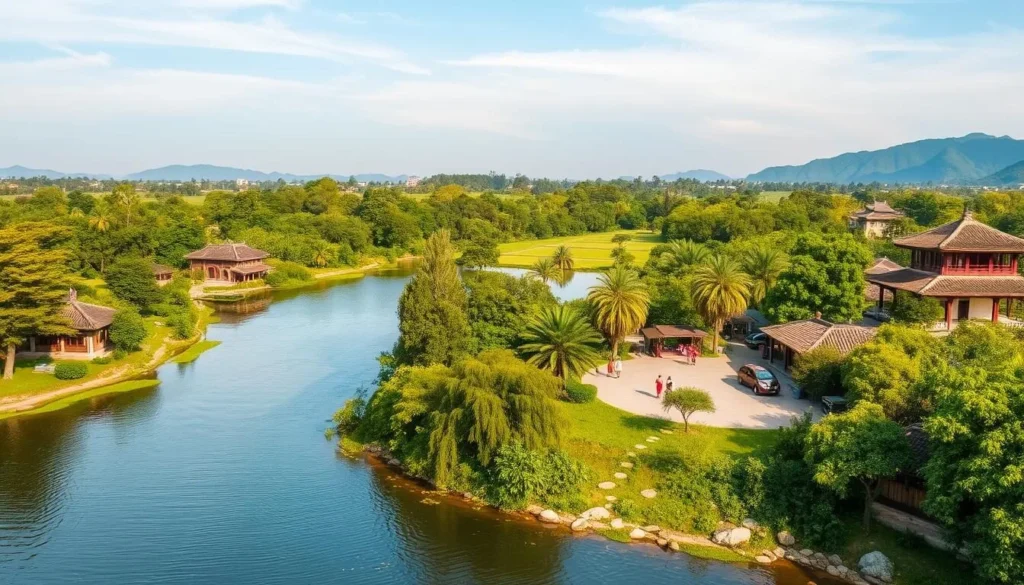
Weather Patterns During Peak Season
During the peak season, Hue experiences gentle weather patterns that are ideal for tourism. The relative humidity hovers between 75-85%, noticeably lower than the 90%+ levels experienced during the rainy season. Wind patterns tend to be gentle, with light breezes rather than the stronger winds that can accompany the changing seasons.
| Month | Morning Temperature | Afternoon Temperature | Rainfall |
|---|---|---|---|
| February | 18-20°C (64-68°F) | 24-26°C (75-79°F) | Minimal |
| March | 19-22°C (66-72°F) | 25-28°C (77-82°F) | Low |
| April | 22-24°C (72-75°F) | 26-30°C (79-86°F) | Low |
The stable weather patterns during the peak season make it easier to plan outdoor activities and excursions to nearby attractions like Bach Ma National Park or Lang Co Beach, making the most of your tour in Hue.
Exploring Hue During the Dry Season (March-August)
The dry season, spanning from March to August, is a significant period for exploring Hue, Vietnam. During this time, the weather is generally warm and dry, making it an ideal period for outdoor activities and sightseeing.
Early Dry Season Benefits
From March to May, Hue experiences the early dry season, characterized by warm weather with low humidity. Temperatures are usually pleasant, ranging between 27-29°C, making it an excellent time for a tour of the city’s historical sites. You can enjoy exploring the Imperial City, the Tombs of the Emperors, and other outdoor attractions without the discomfort of high heat or humidity.
Benefits of Visiting Early in the Dry Season:
- Comfortable temperatures for outdoor sightseeing
- Low humidity, reducing the risk of rain
- Green landscapes following the winter season
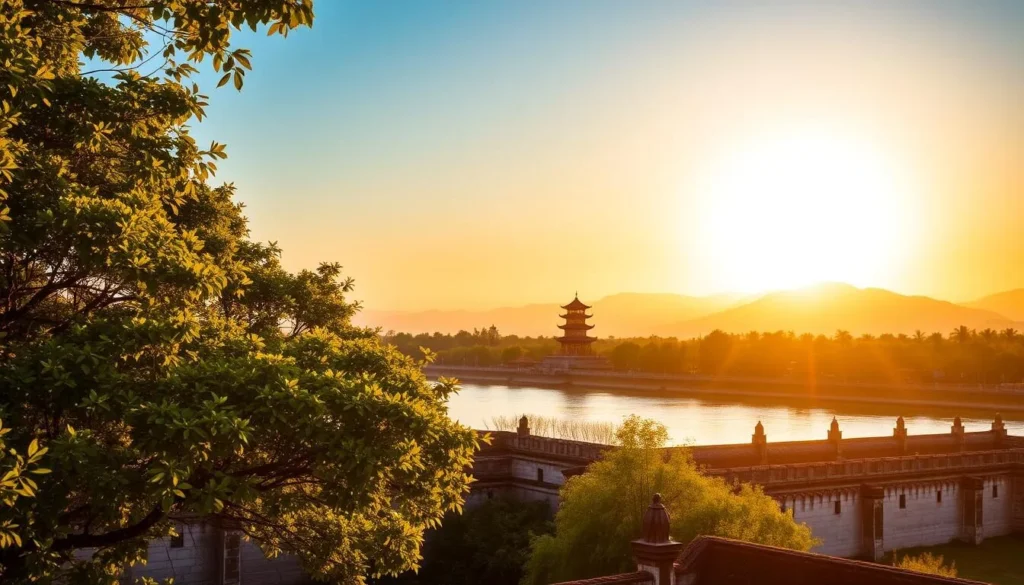
Late Dry Season Considerations
As the dry season progresses into June, July, and August, temperatures in Hue can soar, sometimes reaching as high as 38-40°C. While this intense heat can be challenging, there are still advantages to visiting during this time. The long days allow for extended sightseeing, and with proper planning, you can make the most of your time.
| Month | Average High Temperature | Considerations |
|---|---|---|
| June | 35°C | Early morning and evening activities recommended |
| July | 36°C | Stay hydrated and take breaks in shaded or indoor areas |
| August | 37°C | Consider indoor attractions during the hottest part of the day |
Despite the heat, the late dry season can be a good time for a budget-conscious tour, as fewer tourists mean lower accommodation rates and less crowded attractions.
Summer Heat: Navigating Hue from May to August
Summer in Hue brings with it a unique set of challenges and opportunities for exploration. While the heat can be intense, the city’s vibrant spirit and the surrounding natural beauty offer numerous ways to enjoy your visit.

Coping with High Temperatures
Coping with the high temperatures in Hue during the summer requires some planning. You can start by exploring the city’s nightlife, which comes alive during these months. Visiting the Night Market is a must, offering a cool respite from the day’s heat. For nature lovers, escaping to Bach Ma National Park is a great option, as its higher elevation means cooler temperatures.
Best Outdoor Activities During Hot Months
Despite the challenging heat, summer in Hue offers unique outdoor experiences that take advantage of the dry, sunny weather. You can enjoy:
- Beach excursions to nearby Thuan An Beach or Lang Co Beach, offering refreshing coastal escapes and swimming opportunities.
- Boat cruises along the Perfume River, providing cooling breezes and scenic views, especially during sunset.
- Evening walking tours of Hue, which become especially atmospheric during summer, with the Imperial City and walking streets taking on a magical quality under nighttime illumination.
- Culinary adventures that shift outdoors, with evening street food tours and riverside dining experiences becoming highlights of summer visits.
| Activity | Location | Best Time |
|---|---|---|
| Beach Excursions | Thuan An Beach, Lang Co Beach | Afternoon |
| Boat Cruises | Perfume River | Sunset |
| Evening Walking Tours | Imperial City, Walking Streets | Evening |
Rainy Season in Hue: September to December
From September to December, Hue experiences its rainy season, a period that, despite the weather, holds several advantages for travelers planning their trip.
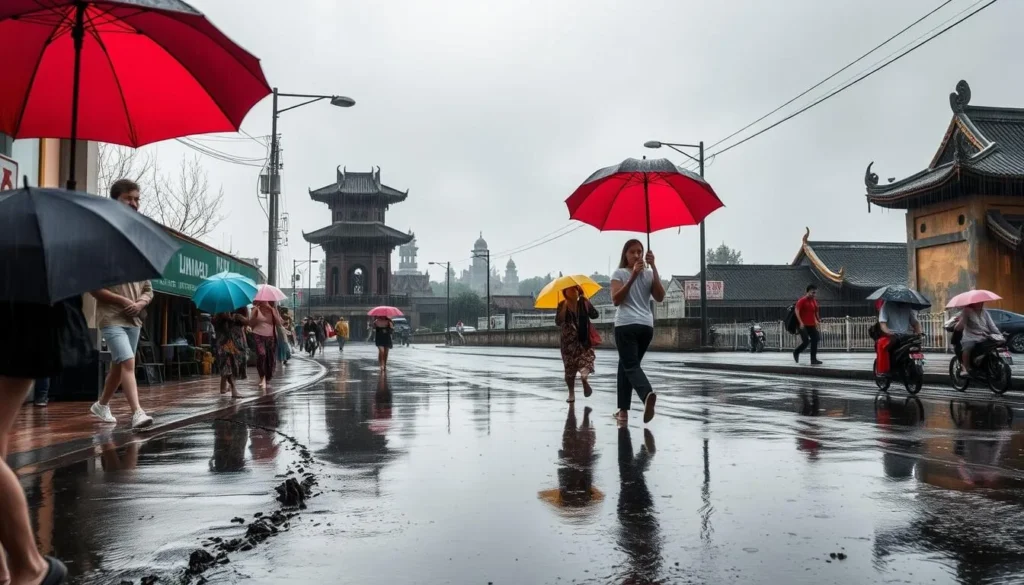
Rainfall Patterns and Challenges
The rainy season in Hue brings significant rainfall, with the most substantial amounts typically occurring in October and November. This period can present challenges for travelers, including potential flooding and limited outdoor activities. However, the rain also brings a lush, green landscape to the city and its surroundings.
Travelers should be prepared for the rain by packing appropriate gear, including waterproof clothing and sturdy footwear. Flexibility in your itinerary is also crucial, allowing for indoor activities during heavy rainfall.
Advantages of Visiting During Low Season
Despite the weather challenges, visiting Hue during the rainy season has its benefits. With fewer tourists, the city’s attractions are less crowded, allowing for a more intimate experience at sites like the Imperial City and royal tombs. Moreover, hotel prices are often discounted by 30-50% compared to peak season, making it an attractive time for budget-conscious travelers.
- Photography enthusiasts can capture unique, moody images of Hue’s monuments amidst misty mornings and dramatic skies.
- The abundant rainfall transforms Hue’s gardens and countryside into vibrant, verdant landscapes.
- Cultural immersion becomes more authentic with fewer tourists, allowing for more meaningful interactions with locals.
Month-by-Month Weather Guide to Hue
To make the most of your visit to Hue, it’s vital to understand its weather patterns month by month. Hue, Vietnam, experiences a diverse climate throughout the year, with significant variations between the dry and rainy seasons.
Winter Months: December to February
During the winter months, Hue experiences relatively cool temperatures, ranging from 18°C to 22°C. It’s a good time to visit if you prefer milder weather, but be prepared for occasional cold fronts. The average rainfall during these months is relatively low, making it a good period for outdoor activities.
Spring Months: March to May
As spring arrives, Hue’s weather becomes warmer and more humid. Temperatures range from 25°C to 30°C, making it an ideal time for sightseeing before the peak summer heat. However, occasional rain showers start to become more frequent towards May.
Summer and Fall Months: June to November
The summer months bring hot and humid weather to Hue, with temperatures often reaching above 35°C. It’s also the start of the rainy season in September, which intensifies through October and November. These months experience heavy rainfall and potential flooding, so it’s advisable to plan indoor activities during this period.
Here’s a summary of the weather conditions during the summer and fall months:
| Month | Temperature Range (°C) | Weather Conditions |
|---|---|---|
| June | 25-34 | Hot, humid, occasional heavy rain |
| July | 25-34 | Hot, high sunshine hours, occasional rain |
| August | 25-33 | Hot, humid, occasional heavy rains |
| September | 24-32 | Start of rainy season, tropical storms possible |
| October | 23-28 | Peak rainfall, potential flooding |
| November | 21-28 | Heavy rainfall, cooler temperatures |
Visiting Hue during the summer can be challenging due to the heat, but it’s a good time to enjoy the nearby beach areas. The transition from summer to fall brings rapidly changing weather patterns, requiring flexible travel planning.
Understanding these seasonal changes helps you plan your trip to Hue more effectively, ensuring that you’re prepared for the temperatures and potential rainy season challenges.
Best Seasonal Activities in Hue
Whether you’re visiting during the dry or rainy season, Hue has plenty of activities to make your trip memorable. The city’s rich cultural heritage and natural beauty offer a wide range of experiences tailored to the season.
Dry Season Experiences
During the dry season, Hue comes alive with outdoor activities. You can explore the Imperial City and its surrounding monuments without the hindrance of rain. The dry weather is perfect for cyclo tours through the countryside, offering a serene view of the rural landscape. Additionally, the dry season is ideal for visiting the Thien Mu Pagoda and taking a leisurely boat ride along the Perfume River.
Rainy Season Alternatives
When the rainy season sets in, Hue transforms into a cozy retreat with plenty of indoor activities. You can plan indoor activities like visiting the Hue Royal Antiquities Museum to delve into the city’s imperial history. The Dong Ba Market offers a great place to experience local culture and shop for souvenirs while staying dry. You can also indulge in culinary workshops and cooking classes to learn the secrets of Hue’s distinctive cuisine. Furthermore, Hue’s traditional tea houses and cafés provide a warm and welcoming atmosphere to enjoy local beverages.
Other rainy day alternatives include exploring traditional craft villages around Hue, which offer covered demonstrations of local crafts, and treating yourself to spa treatments and wellness experiences.
Cultural Festivals and Events by Season
Immerse yourself in Hue’s culture by participating in its numerous festivals and events held throughout the year. The city’s rich heritage is showcased through various celebrations, offering a unique experience for visitors.
Tet Holiday and Spring Celebrations
The spring season in Hue is marked by the Tet Holiday, a significant cultural event in Vietnamese culture. The biennial Hue Festival, held in even-numbered years, typically in April or June, is a highlight of the spring season. This grand event features royal ceremonies, folk performances, and traditional Vietnamese music, creating an immersive cultural experience. During this time, the entire city becomes a stage with performances at the Imperial City and along the Perfume River.
Summer and Fall Festivals
Summer and fall in Hue bring a range of cultural events, including Buddha’s Birthday celebrations in May, which transform the city’s Buddhist temples with colorful decorations and special ceremonies. The Mid-Autumn Festival in September is another highlight, featuring magical lantern displays and traditional performances. Local harvest and craft festivals in the surrounding villages offer authentic cultural experiences away from typical tourist attractions.
Weather-Based Itineraries for Hue
To make the most of your time in Hue, it’s essential to plan your itinerary around the weather. Hue, Vietnam, is a city that offers a rich cultural experience, but the weather can significantly impact your travel plans.
3-Day Perfect Weather Itinerary (January-April)
Visiting Hue during the dry season allows you to enjoy the city’s outdoor attractions without the hindrance of rain. Here’s a suggested 3-day itinerary:
- Day 1: Explore the Imperial City in the morning, followed by lunch at a local restaurant, and then visit the Thien Mu Pagoda.
- Day 2: Take a cooking class to learn about traditional Hue cuisine, followed by a visit to the Dong Ba Market.
- Day 3: Visit the Hue Royal Antiquities Museum, and then head to the nearby Tu Hieu Pagoda for a peaceful afternoon.
This itinerary allows you to experience the best of Hue’s culture and history during the dry season.
Making the Most of Challenging Weather Periods
If your visit falls during the rainy season, don’t worry—Hue offers plenty of indoor attractions to explore. You can plan indoor activities such as visiting the Hue Royal Antiquities Museum to learn about the Nguyen Dynasty, or shopping for souvenirs at Dong Ba Market.
| Activity | Location | Weather Condition |
|---|---|---|
| Visit Museum | Hue Royal Antiquities Museum | Rainy |
| Shopping | Dong Ba Market | Rainy |
| Cooking Class | Traditional Hue Cuisine | Any |
By planning your tour around the weather, you can still have a fulfilling experience in Hue. Whether it’s exploring indoor attractions or enjoying outdoor activities during the dry season, there’s always something to do in this vibrant city. You can discover new things and make unforgettable memories.
Packing Tips for Hue’s Variable Climate
Hue’s variable climate requires careful planning and packing to ensure a comfortable journey. Whether you’re visiting during the dry season or navigating the rainy months, being prepared is key to enjoying all that Hue has to offer.
Dry Season Essentials
During the dry season, from March to August, the focus should be on comfort and sun protection. Lightweight, breathable clothing is a must, along with a good sunscreen, a hat, and sunglasses to shield against the sun’s strong rays. Comfortable walking shoes are also essential for exploring Hue’s historical sites and vibrant streets.
- Lightweight clothing
- Sunscreen and sun hat
- Sunglasses
- Comfortable walking shoes
Rainy Season Must-Haves
For the rainy season, which spans from September to February, rain gear becomes indispensable. A quality, packable rain jacket with a hood is crucial, along with quick-drying clothing that can handle the high humidity. Waterproof shoes or sandals with good traction are also vital for navigating wet streets. Additionally, consider packing a waterproof phone case or pouch to protect your electronics during unexpected downpours.
- Packable rain jacket
- Quick-drying clothing
- Waterproof shoes or sandals
- Waterproof phone case or pouch
By packing smart and being prepared for Hue’s variable climate, you can ensure a enjoyable and stress-free trip, regardless of the season you visit.
Day Trips from Hue Based on Weather Conditions
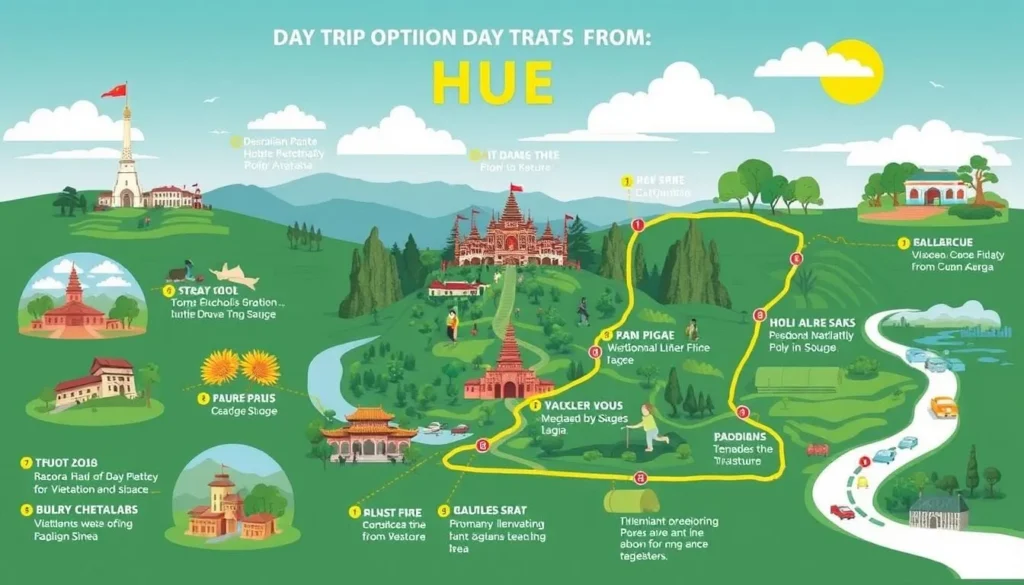
Whether it’s hot or raining, Hue offers a variety of day trips that cater to different weather conditions, ensuring a great experience. You can plan your excursions based on the weather to make the most out of your visit.
Beach Escapes During Hot Months
During the hot months, a beach escape is an ideal day trip from Hue. You can head to nearby beaches that offer a cool retreat from the heat.
The beautiful beaches near Hue, such as Lang Co Beach, provide a perfect setting for relaxation and water activities. You can enjoy the sun, sand, and sea, making for a memorable day trip.
Indoor-Friendly Excursions for Rainy Days
If your visit falls during the rainy season, don’t worry—Hue offers plenty of indoor attractions to explore. You can visit the Hue Royal Antiquities Museum to discover artifacts from the Nguyen Dynasty.
Other indoor activities include exploring Dong Ba Market for local culture and souvenirs, enjoying traditional Vietnamese coffee at cozy cafes, and visiting spiritual sites like Thien Mu Pagoda and Tu Hieu Pagoda.
Some excellent day trip options for rainy days include:
- Alba Thanh Tan Hot Springs: Relax in covered thermal pools and enjoy spa facilities.
- Lebadang Memory Space: Explore contemporary art in a spacious indoor gallery.
- Phuoc Tich Ancient Village: Engage in pottery making and other crafts in indoor workshops.
- Laguna Lang Co: Enjoy indoor swimming, dining, and entertainment.
- Phu Loc district: Participate in indoor fish sauce workshops and savor local seafood.
Conclusion: Planning Your Perfect Hue Adventure
Planning a trip to Hue requires considering the city’s unique climate patterns to ensure a smooth and enjoyable travel experience. The optimal time to visit is between January and April, when comfortable temperatures and minimal rainfall create ideal conditions for exploration. However, each season offers distinct advantages, from the vibrant festivals of winter to the budget-friendly options of the rainy season. By understanding these seasonal variations and being flexible with your trip plans, you can have a rewarding journey in Hue, regardless of when you visit.
The above is subject to change.
Check back often to TRAVEL.COM for the latest travel tips and deals.
